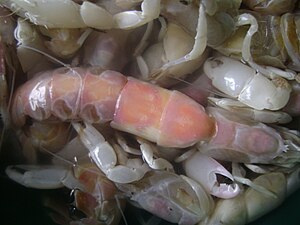Lepidophthalmus turneranus
| Lepidophthalmus turneranus | ||||||||||||
|---|---|---|---|---|---|---|---|---|---|---|---|---|

Lepidophthalmus turneranus |
||||||||||||
| Systematics | ||||||||||||
|
||||||||||||
| Scientific name | ||||||||||||
| Lepidophthalmus turneranus | ||||||||||||
| ( White , 1861) |
Lepidophthalmus turneranus ( Syn . : Callianassa turnerana ), also known as (blue) Cameroon shrimp, is a decapod native to the west coast of Africa. Occasional shoals in the Cameroon Estuary region areused for fishing. The Portuguese called the river Wouri in the 15th century because of such a swarm “Rio dos Camarãos”, which led to the current name of the country Cameroon .
features
Lepidophthalmus turneranus reaches body lengths of 5.5 to 14.5 cm. The segments 3 to 5 of the abdomen are smooth on the back. The telson is somewhat wider than it is long and also smooth, without any noticeable ridges. The adjacent endopodites of the uropods are significantly longer than the telson. In adult animals, the rostrum protrudes distally beyond the eyes and consists of three or five equally long teeth. In young animals, this feature may be less pronounced or still absent. The base of the first pair of antennas is much larger than that of the second pair.
Female specimens have a crescent-shaped depression on the palms of the scissors on the first pair of striding legs , which is missing in males.
distribution and habitat
The species is native to the coastal waters of the Gulf of Guinea , the distribution ranges from the Ivory Coast in the north to the Republic of the Congo in the south. Especially lagoons and estuaries are populated, so that Lepidophthalmus turneranus can be found in both salt water and brackish water .
Like most species of Callianassidae, Lepidophthalmus turneranus lives in self-dug mud caves in the sea floor. Every three to five years, the cave passages are left to swarm into the estuaries.
use
Lepidophthalmus turneranus is the only species of the Callianassidae family that is used as food for humans. During the swarming into the estuaries, these shrimp are mainly caught in baskets. Females are eaten whole, while an ingredient in males is said to be irritating to the throat. Oil is obtained from male pleons by pressing .
Taxonomy
The species is named after James Aspinall Turner and was first described in 1861 by Adam White as Callianassa turnerana . K. Sakai put the species in 1999 in the genus Lepidophthalmus , u. a. due to the multi-pointed rostrum typical of this genus and the non-elongated carpus on the scissor-carrying first stride leg in males.
Synonyms are Callianassa krukenbergi Neumann, 1878 , Callianassa diademata Ortmann, 1891 , Callianassa turnerana White, 1861 and Callichirus turneranus (White, 1861) .
swell
- Lipke B. Holthuis: Marine Lobsters of the World . An Annotated and Illustrated Catalog of Species of Interest to Fisheries Known to Date. Ed .: Food and Agriculture Organization (= FAO Fisheries Synopsis . Volume 125 ). Rome 1991, ISBN 92-5103027-8 , pp. 250-252 ( etibioinformatics.nl ).
Individual evidence
- ↑ PC Dworschak, DL Felder, CC Tudge: Infraorders Axiidea de Saint Laurent, 1979 and Gebiidea de Saint Laurent, 1979 (formerly known collectively as Thalassinidea) . In: FR Schram, JC von Vaupel Klein, M. Charmantier-Daures, and J. Forest (Eds.): Treatise on Zoology - Anatomy, Taxonomy, Biology - The Crustacea, Decapoda, Volume 9 Part B Decapoda: Astacidea PP (Enoplometopoidea , Nephropoidea), Glypheidea, Axiidea, Gebiidea, and Anomura . 2012, p. 109–219 ( nhm.org [PDF; 7.0 MB ; accessed on May 8, 2012] Lepidophthalmus turneranus on page 180).
- ^ Adam White: Descriptions of two species of Crustacea belonging to the families Callianassidæ and Squillidæ . In: Proceedings of the Zoological Society of London . 1861, p. 42 f . ( biodiversitylibrary.org [accessed March 22, 2012]).
- ↑ K. Sakai: Synopsis of the family Callianassidae, with keys to subfamilies, genera and species, and the description of new taxa (Crustacea: Decapoda: Thalassinidea) . In: Zoological Negotiations . tape 326 , 1999, pp. 3–152 ( arthroinfo.org [PDF; 9.0 MB ; accessed on March 22, 2012]).
